The Nabataeans greatest accomplishment was probably their system of water management. They developed a system to collect rainwater using water channels, pipes, and underground cisterns. Added to this, they developed very strong, waterproof cement, some of which is still in existence to this day.
They also developed sophisticated ceramic pipelines and reservoirs using gravity feeds (siphons or inverted siphons), that served the developing urban centers. Outside of the cities, dams closed off wadis to collect water during the rainy season, while stone circles or terraces retarded runoff from slopes and trapped valuable topsoil so that their irrigation lines could feed crops.
The Nabataeans were experts at collecting water and storing it in underground cisterns. All along their caravan routes, secret water collection systems collected water and stored it for later use. The ancient historian Diodorus noted: “For in the waterless region, as it is called, they have dug wells at convenient intervals and have kept the knowledge of them from people of all other nations, and so they retreat in a body into this region out of danger. For since they themselves know about the places of hidden water and open them up, they have for their use drinking water in abundance.” (II.48.2)
Diodorus also noted in another place: “They take refuge in the desert using this as a fortress; for it lacks water and cannot be crossed by others, but to them alone, since they have prepared subterranean reservoirs lined with stucco, it furnishes safety. As the earth in some places is clayey and in others is of soft stone, they make great excavations in it, the mouths of which they make very small, but by constantly increasing the width as they dig deeper, they finally make them of such size that each side has a length of about 100 feet. After filling these reservoirs with rain water, they close the openings, making them even with the rest of the ground, and they leave signs that are known to themselves but are unrecognizable to others. They water their flocks every other day, so that, if they flee, or wander through waterless places, they may not need a continuous supply of water.” (XIX.94.6-9)
The Nabataeans perfected the art of creating a perfect cube cistern, with corners that formed perfect right angles. They sometimes added perfectly made stone support pillars with accurately spaced, combed, oblique stone dressing. Onto this prepared surface, they plastered cement composed of water-resistant plaster of unmatched quality. Archeologists feel that this must have taken them hundreds of years to develop and perfect.
The well made reservoirs that Diodorus says were common in his day, point to the fact that the Nabataeans must have been developing this skill during earlier years, perhaps back to the time of the Babylonians, or even the Assyrians. Perhaps they learned some of their skill from the people of southern Arabia, who were creating basic waterworks during the Iron Age.
Herodotus, when writing about the Nabataeans tells us, that he believed they could find water anywhere in the desert. He mentions that Cambyses used an Arab to bring him water in the desert as he moved his army against Egypt. The Nabataeans refused to tell the army where water came from, but they showed up at regular intervals in the desert, with their camels loaded with water skins, enabling the army to pass across the desert into Egypt. The Nabataeans made up a story by explaining that there was a wonderful river in the desert and that they used a water duct made of sewn ox-hides to transport the water over many miles. Herodotus thought that the story was not very credible. (History III.5, 7-9) What probably happened was that the Nabataeans, in exchange for financial return, simply supplied the army with water from their secret cisterns that were scattered along the caravan route; which would most likely be the route that the army took. By telling stories, however, they could keep their water sources secret and at the same time, profit handsomely, a typical Nabataean trait.
Today these water collection systems still dot the desert but there are still more that have yet to be discovered. Many of these are still in use, proving the quality of the ancient Nabataean water-proof cement. These cisterns provided Nabataean camel caravans a way to pass through the desert without needing to use the water wells that were controled by the local tribes. This gave the Nabataeans a distinct edge in the frankincense trade as they could pass through desolate desert areas where others would die of thirst. This provided them with a means of protection, as their caravans could pass undetected through the desert. It also provided the Nabateans with places of refuge where they could escape to in times of war and oppression.
Nabataea.Net has organized several excusions into the Hishma desert to discover and map some of these water collection systems. The pictures below were taken from a lone mountain in the desert, where the Nabataeans harvested water. This location was probably used as a caravan stopping station before the city of Humeima was built. At one location the buildup of centuries old camel dung is over a meter high. This mountain is located at: N 29 52.970, E 035 21.366. It is accessible only by a 4 wheel drive.
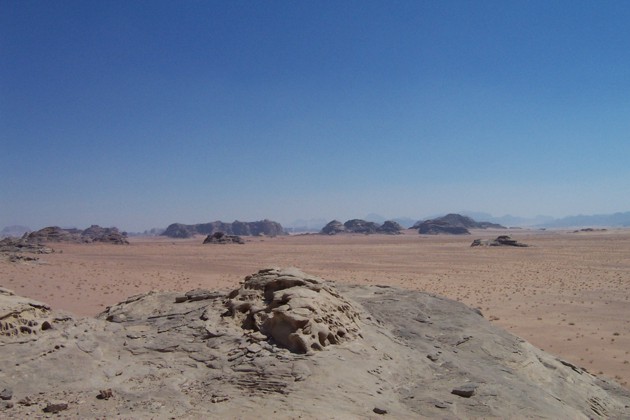
The kind of mountains that the Nabataeans used to collect water.
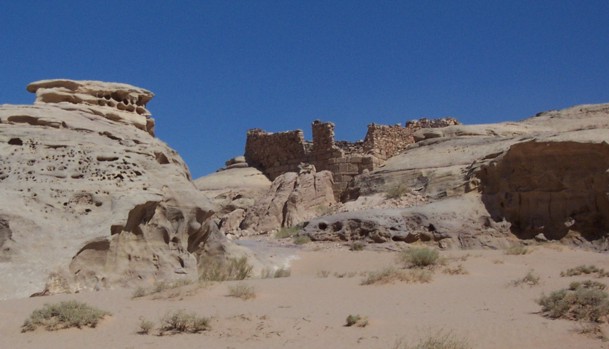
The north dam, seen from below. The small-stone structure above was probably added in the last 100 years to shade the water from the intense sun. The local Bedouin have cleaned out the cistern and this dirt is piled against the large rocks of the Nabataean dam.

The original reservoir was covered. Along the edge of the reservoir are the notches where the arches fit into the side walls. This stone roof probably collapsed during an earthquake, and was later dug out when Bedouin tribes entered the area.

A small lookout tower was located at the very highest point on the mountain. While it was almost invisible to passers-by, a lookout could see for miles across the desert.

A cut water channel brought water from the top of the mountain.

One of our younger explorers stands at the top of the mountain where the lookout tower was located.

The Nabataeans ran a small ledge all around the top of the mountain in order to funnel the water into the cistern. This small ledge was not visable to those passing by, unless they actually climbed the mountain and traced the stones back to the cistern.
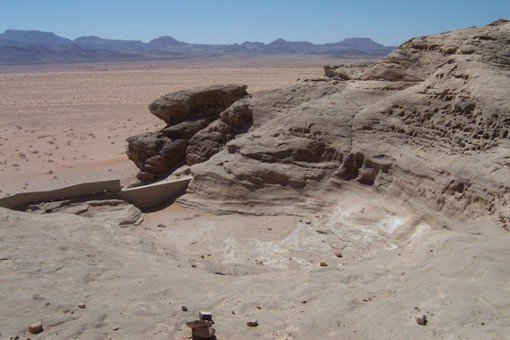
On the west side of the mountain a modern cement dam has been built over the old Nabataean stone dam.
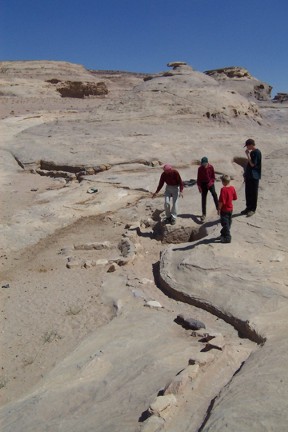
A cut water channel collected the runoff and directed it into the cistern.
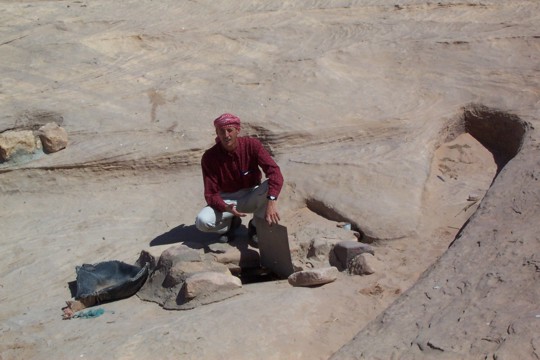
On the rocks across from the dam is another cistern. This one is flush with the surface, and collected the water that ran off of the western extension of the mountain. This cistern would have been invisible to anyone passing by, and is only visible from a hundred feet or so away.
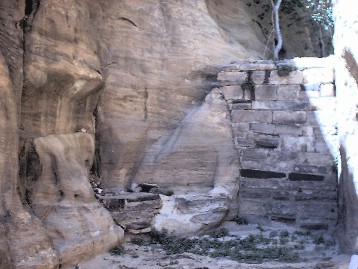
This dam, hidden back in a crevice held a large amount of water. The water tank was originally covered, although it has colapsed today. Nabataean inscriptions can be found on the walls near this spot.








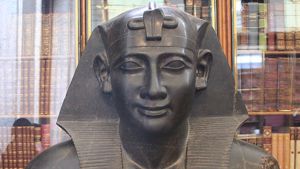





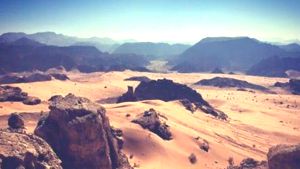

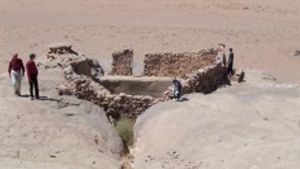

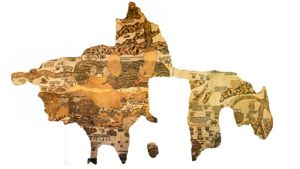

Page Discussion
Membership is required to comment. Membership is free of charge and available to everyone over the age of 16. Just click SignUp, or make a comment below. You will need a user name and a password. The system will automatically send a code to your email address. It should arrive in a few minutes. Enter the code, and you are finished.
Members who post adverts or use inappropriate language or make disrespectful comments will have their membership removed and be barred from the site. By becoming a member you agree to our Terms of Use and our Privacy, Cookies & Ad Policies. Remember that we will never, under any circumstances, sell or give your email address or private information to anyone unless required by law. Please keep your comments on topic. Thanks!